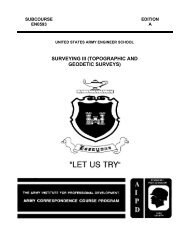SUBCOURSE EDITION - Modern Prepper
SUBCOURSE EDITION - Modern Prepper
SUBCOURSE EDITION - Modern Prepper
You also want an ePaper? Increase the reach of your titles
YUMPU automatically turns print PDFs into web optimized ePapers that Google loves.
INSTRUCTIONAL CONTENT1. Now that you are familiar with the components of DA Forms 1941 and 1932, you will now learnhow to prepare the map projection. The earth is not a sphere but a spheroid (oblate, or flattened at thepoles), and the various determinations of the shape of the spheriod are normally differentiated by theirdegree of flattening. The central problem in mapping and in projections is that no matter how small anarea we might choose to map, there is still the problem of flattening. That is, the area of the earth'ssurface to the mapped, must be drawn to scale on a flat surface--a sheet of paper. A map projection isthe systematic drawing of lines representing the meridians and parallels on the flat surface. Therefore,in laying out a projection the location of the intersections of lines of latitude and longitude (thegraticules) are computed in accordance with the selected spheroid. Grids are applied to military maps toprovide a uniform system for referencing or locating the position of points, and to assist in artilleryoperations. Grids are added because the converging meridians, as they intersect the parallels, delineateirregular shapes on the earth's surface. Therefore, positional relationships between points are not easilydetermined on this irregular figure pattern. However, there is a definite relationship between the gridand the graticule. So for each grid position, a corresponding geographic position can be determined.a. A representation of the earth's curved surface cannot be projected onto a plane surface andretain all distances, angles, and area in true relationship to one another. However, for small areas,distortion is often negligible so that the earth's surface may be mapped by frequently changing theposition of the plane or changing the system of projection. The projections used as the framework formilitary maps have a common factor, they are all of the conformal type. Conformality implies that allareas upon the earth's surface retain their true shape upon the projection; therefore, the meridians andparallels intersect at right angles and they may be straight or curved lines. Military topographic maps ofscales larger than 1:50,000 of areas between 80° south and 84° north are produced on the TransverseMercator Projection. This is the most common projection that an Army cartographer will work with.b. Although, in reality, a UTM grid is superimposed on a Transverse Mercator Projection, theconstruction of these is reversed. When constructing a map base, the grid is constructed first then theprojection is plotted on the grid.2. Plotting of projection corners. The construction of the four projection corners is a simple,mechanical operation of setting the centimeter measurements on the dividers from the invar scale, andplotting these measurements in the directions indicated on the form. The intersection of the two plottedvalues is the sheet corner. Listed on the next page are the steps involved in plotting the projectioncorner. Each step is then followed by a detailed description of how to perform the operation.67
















